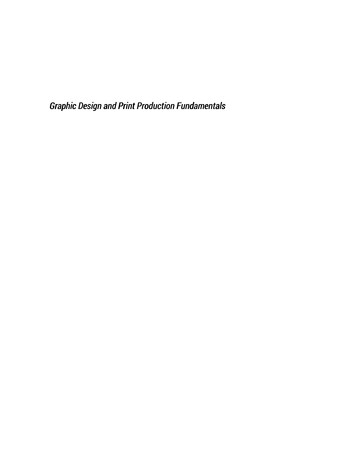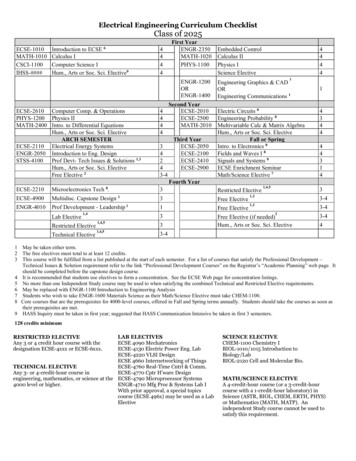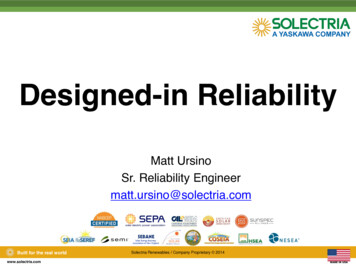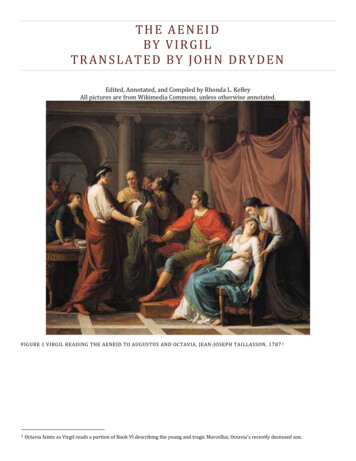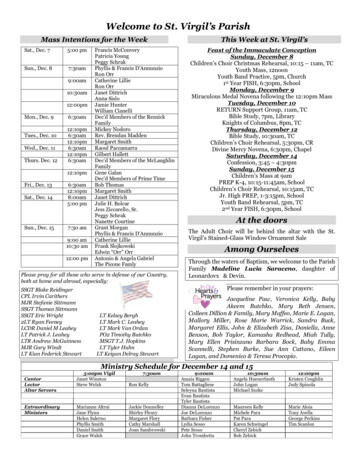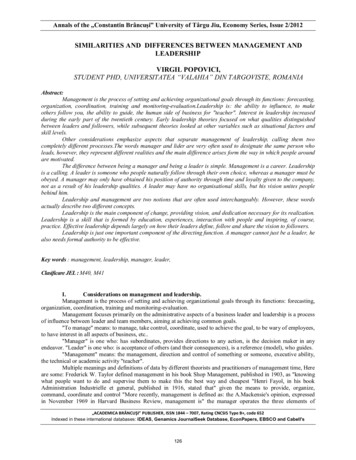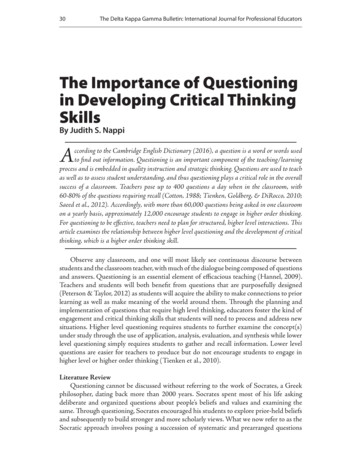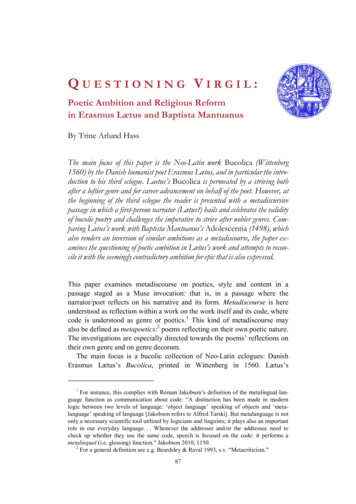
Transcription
QUESTIONING VIRGIL:Poetic Ambition and Religious Reformin Erasmus Lætus and Baptista MantuanusBy Trine Arlund HassThe main focus of this paper is the Neo-Latin work Bucolica (Wittenberg1560) by the Danish humanist poet Erasmus Lætus, and in particular the introduction to his third eclogue. Laetus’s Bucolica is permeated by a striving bothafter a loftier genre and for career advancement on behalf of the poet. However, atthe beginning of the third eclogue the reader is presented with a metadiscursivepassage in which a first-person narrator (Lætus?) hails and celebrates the validityof bucolic poetry and challenges the imperative to strive after nobler genres. Comparing Lætus’s work with Baptista Mantuanus’s Adolescentia (1498), whichalso renders an inversion of similar ambitions as a metadiscourse, the paper examines the questioning of poetic ambition in Lætus’s work and attempts to reconcile it with the seemingly contradictory ambition for epic that is also expressed.This paper examines metadiscourse on poetics, style and content in apassage staged as a Muse invocation: that is, in a passage where thenarrator/poet reflects on his narrative and its form. Metadiscourse is hereunderstood as reflection within a work on the work itself and its code, wherecode is understood as genre or poetics.1 This kind of metadiscourse mayalso be defined as metapoetics:2 poems reflecting on their own poetic nature.The investigations are especially directed towards the poems’ reflections ontheir own genre and on genre decorum.The main focus is a bucolic collection of Neo-Latin eclogues: DanishErasmus Lætus’s Bucolica, printed in Wittenberg in 1560. Lætus’s1For instance, this complies with Roman Jakobson’s definition of the metalingual language function as communication about code: “A distinction has been made in modernlogic between two levels of language: ‘object language’ speaking of objects and ‘metalanguage’ speaking of language [Jakobson refers to Alfred Tarski]. But metalanguage is notonly a necessary scientific tool utilized by logicians and linguists; it plays also an importantrole in our everyday language. . . Whenever the addresser and/or the addressee need tocheck up whether they use the same code, speech is focused on the code: it performs ametalingual (i.e. glossing) function.” Jakobson 2010, 1150.2For a general definition see e.g. Beardsley & Raval 1993, s.v. “Metacriticism.”87
THE METADISCOURSE OF RENAISSANCE HUMANISMRenæssanceforum 11 2016 www.renaessanceforum.dkTrine Arlund Hass: Questioning Virgilintroduction to the third eclogue will be the core of the study. In this poemwe are presented with a metadiscursive passage in which the narrator statesthat the bucolic form should be considered as valid in its own right, and that,in spite of traditional views, such genres as tragedy and heroic epic shouldnot necessarily be the object of the poet’s ambitions. In view of the overalldesign of the work, this statement seems peculiar, since there is a generalmovement towards heroic epic in the work, especially towards the end,where the poet recommends himself as capable of loftier genres.The paper has three parts. After an initial presentation of the metadiscourse in question and its role in bucolic poetry, the introduction of Eclogue3 will, first, be treated with regard to intertextuality to see how it relates toVirgil, the most important classical model in this period. The aim is to showhow Lætus inverts his classical model so as to present an alternative statement. Secondly, Lætus’s passage will be compared to Eclogue 5 of theinfluential work, Adolescentia, 1498, by the Carmelite poet Baptista Mantuanus (Mantuan), where we also find an unusual rejection of poetic ambitionpresented as a metadiscourse. The analysis of Mantuan is contextualized inthe paper’s third part, where the circumstances and immediate fortuna of thework are considered and compared to the political and religiouscircumstances of Lætus’s Bucolica. In this light, an interpretation of Lætus’smetadiscourse is suggested that will allow the seemingly contrastingstatements about poetic ambition in his work to be reconciled.Bucolic poetry and metadiscoursivityA frequent theme of metareflections in bucolic poetry is tension betweenform and content. From its very origin, one of the core elements of thisgenre has been the tension between low and high style. In Theocritus’sIdylls, simple shepherds converse in rustic Doric dialect, but their lines areorganized in effortless hexameters, the epic metre, and many of their storiesand descriptions of pastoral events and objects are intertextual and based onHomeric sources or hypotexts, to use Genette’s term.3 Virgil too employsthe tension between simple and complex, low and high in his Eclogues. Atthe beginning of his fourth eclogue, this tension is verbalized by the narratoras he admits to transgressing the limits of the humble bucolic universe inorder to describe the coming of the Golden Age:3Genette 1997, 5: “By hypertextuality I mean any relationship uniting a text B (which Ishall call the hypertext) to an earlier text A (I shall, of course, call it the hypotext), uponwhich it is grafted in a manner that is not that of commentary.” In this text, intertextuality,the term coined by Julia Kristeva, is used to designate the imitative relationship betweentexts on a general level. Genette has suggested the alternative term transtextuality.88
THE METADISCOURSE OF RENAISSANCE HUMANISMRenæssanceforum 11 2016 www.renaessanceforum.dkTrine Arlund Hass: Questioning VirgilSicelides Musae paulo maiora canamusNon omnis arbusta iuvant humilesque myricae;Si canimus silvas, silvae sint consule dignae.(Sicilian Muses, let us sing a somewhat loftier strain. Not all do theorchards please and the lowly tamarisks. If our song is of the woodland, let the woodland be worthy of a consul. Virgil, Eclogue 4. 1–3)4The Muses are invited to inspire a slightly more elevated song to pleasethose who do not favour the low style. They will still sing of rural matters,but in a way refined enough to please distinguished people accustomed tourbane poetry in the high style. The Sicilian Muses are the Muses ofTheocritus of Sicily: they inspire and cherish bucolic poetry and style; andthe trees and tamarisks, although they have figurative meaning, may evokeassociations with the woodland Muse addressed at the beginning of thecollection: “Tityre tu patulae recubans sub tegmine fagi/ silvestrem tenuiMusam meditaris avena;” (You, Tityrus, lie under your spreading beech’scovert, Wooing the woodland Muse on slender reed: Virgil, Eclogue 1.1–2).5 The invocation to the Muses in Virgil’s Eclogue 4.1–2 can, consequently, be read as a metadiscourse, a verbalized reflection on thedecorum of the bucolic genre in which Virgil’s narrator voice is discussingthe code of the poem he is introducing by considering the relationshipbetween code, content, and receivers.For the Renaissance humanists, it was not only Virgil, but the LateAntique understandings of his life and works that influenced the conceptionand orchestration of Latin poetry in the Virgilian genres. 6 In the prefaces tothe Late Antique commentaries, the conventional intratextual tensionbetween bucolic and epic poetry is associated with Virgil’s literary career.Donatus’s preface to the lost commentary on the Eclogues assigns the threelevels of style to the three Virgilian genres:aut cum tres modi sint elocutionum, quos χαρακτῆρας Graeci uocant,ἰσχνός qui tenuis, μέσος qui moderatus, ἁδρός qui ualidus intellegitur,credibile erit Vergilium, qui in omni genere praeualeret, Bucolica adprimum modum, Georgica ad secundum, Aeneidem ad tertium uoluisse conferre.4Tr. Fairclough, see Virgil 1935.Ibid.6The popularity of the works by Servius and Donatus is reflected in the amount of editions of the commentaries circulating in the Renaissance. Servius tops Wilson-Okamura’s listof “Virgil commentaries ranked by number of printings”. He has registered 119 editions ofthe commentary on the Eclogues printed between 1469 and 1599 with 119 editions. Donatus’s Vita is second on the list with 107 editions. Wilson-Okamura 2010, 31–35 & 268.589
THE METADISCOURSE OF RENAISSANCE HUMANISMRenæssanceforum 11 2016 www.renaessanceforum.dkTrine Arlund Hass: Questioning Virgil(or, since there are three styles [modi] of speech – what the Greekscall charaktêrai: ischnos, which is understood to mean “meagre” [tenuis]; mesos, “moderate” [moderatus]; and hadros, “powerful” [validus] – one might think that Virgil desired to devote his Bucolics to thefirst mode, his Georgics to the second, and the Aeneid to the third, inorder to distinguish himself in every kind [genus] of poetry. Donatus,Vita Virgilii 58–59)7This passage may seem to force a label of low or simple style on theEclogues, but at the same time it underlines the link between that poeticgenre and the higher literary styles, because the three genres – bucolic,didactic and heroic epic poetry – are presented as a coherent hierarchy. Thismeans that engagement in the composition of Virgilian eclogues inherentlyprompts the reader to envision his progression towards didactic and heroicepic; and this same expectation arises for the poet who subscribes to thetraditional understanding of Virgil.For the humanists, this way of reading and understanding Virgil was sowell established that it is expressed in the humanistic bucolic poems proper.The conception of bucolic poetry as a stepping stone, working in parallelwith the conception of Virgil’s poems as autobiographical allegories, makesway for metadiscourses about how and with what purpose bucolic poetry isto be composed. Petrarch can serve as example: in the first eclogue of hisBucolicum Carmen, Petrarch’s poetic persona is presented with a simplepastoral life in the religious orders, which he rejects in favour of a moretroublesome secular path. He chooses Homer and Virgil as his role-modelsin preference to the David of the Old Testament, who is presented as analternative model, and his endeavours to pursue his ideal are what drive thegeneral plot of the work forward. This choice leads to the presentation of ajourney shaped after the Virgilian career model, leading from Vaucluse toItaly and from bucolic poetry towards heroic epic.8 Petrarch’s use of Virgilas model not only for his poetry but for the description of his career thus7Tr. Wilson-Okamura, see Donatus 2008. Servius has the same classification, but usesthe following terms for the three genera dicendi: humile, medium, grandiloquum (Servius,In Vergilii Bucolicon Librum, Pr. l. 16–21).8For an introduction to Bucolicum Carmen, its themes and general plot, and a readingof the twelve eclogues as an allusion to the twelve books of Virgil’s Aeneid, see Carrai2009. Hass 2013b treats Eclogue 11 of Bucolicum Carmen as a key to the fictionalization ofPetrarch’s poetic career in order to make it match the Virgilian model. This text alsoconsiders Perarch’s notations in Ambr. S. P. 10/27 where both Virgil’s text and Servius’commentary is annotated. Laird 2010 investigates the role of Virgil’s career for Petrarchand confirms how Petrarch displays his works as following Virgil’s model although that isa fictionalization of reality (esp. Laird 2010, 145-47).90
THE METADISCOURSE OF RENAISSANCE HUMANISMRenæssanceforum 11 2016 www.renaessanceforum.dkTrine Arlund Hass: Questioning Virgilconfirms how dependent he is on the conception of the Virgilian genres thatgoes back at least to Late Antiquity. In this context, his work functions as anexample of what develops into a tendency: one, however, that is directlyopposed by Mantuan’s work and seemingly questioned by Lætus’s Eclogue3, as we shall see in the following.9Erasmus Lætus’s Eclogue 3Bucolica is a collection of seven Neo-Latin eclogues written by the Danishtheologian Erasmus Lætus (ennobled in 1563), published in Wittenberg in1560.10 Lætus was an important intellectual and poetic figure in sixteenthcentury Denmark. In 1559, the year before he published the Bucolica, hewas made professor of theology at the university in Copenhagen. In 1560,Lætus was in Wittenberg to obtain the doctorate degree in theology requiredto take up the office of professor. Lætus actually managed to imitate Virgil’sliterary career. He wrote several other extensive works of Latin poetry.Among them are a didactic poem, De Re Nautica (Basel 1573), dedicated tothe city council of Venice, and two epic poems, Margaretica (Frankfurt amMain 1573), dedicated to Queen Elizabeth of England, and Res Danicae(Frankfurt am Main 1574) dedicated to Danish King Frederik II.Current research agrees that Lætus’s Bucolica is permeated by personaland poetic ambition.11 The work has a dedicatory letter by none other thanPhilipp Melanchthon, addressed to none other than the Danish king,Frederik II (r. 1559–1588), and although only two of its seven ecloguesexplicitly treat matters of kings, these two poems take up half of the totalnumber of verses in the work: 1,607 of 3,215 verses.12 Lætus’s poeticpersona is staged as a main character in the work, while he himself does notfigure as interlocutor until the last eclogue. This poem begins with theclassical Muses being translated to Denmark in the sense of a translatiostudii. The poem is set just outside Copenhagen, indicating that Lætus isready to enter the city and take up the urbane poetic genres. The ending ofthe work should be seen as an offer to the Danish King: Lætus offers hisservices as court poet, as he offers King Frederik the poetic fame and praiseof a Renaissance prince; Lætus can make Frederik into a Danish Augustus ifthe King supports him and allows him to become a Danish Virgil, and9For a survey of Neo-Latin pastoral see e.g. Marsh 2014, s.v. ‘Pastoral,’ who confirmsthe above-described tendency.10An account of Lætus’s life in English can be found in Skovgaard-Petersen & Zeeberg,1992, 399–400.11See especially Skafte Jensen 1984 & 2004, and Zeeberg 2010.12This division is identified by Skafte Jensen 2004, 27–36.91
THE METADISCOURSE OF RENAISSANCE HUMANISMRenæssanceforum 11 2016 www.renaessanceforum.dkTrine Arlund Hass: Questioning Virgiltogether the two of them can turn Copenhagen, and Denmark, into a newRome.13However, this ambition, which otherwise seems to tie the work together,is questioned by the narrator in another central location of the work,Eclogue 3, which is the centrepiece of the first part of the collection.Eclogue 3 opens with a dedication to Philipp Melanchthon in v. 1–22 whichwill be discussed below. First, we shall see how Lætus addressesMelanchthon (v. 1–6); and then there follows an analysis of how the keypassage at v. 7–22 is shaped after Virgil’s Eclogue 4.The beginning of Eclogue 3 reads as follows:Pastorum Musam Iustique et Thyrsidis, æquoCertatam studio, lepidisqué relatibus auctam,Dicemus. Tu nostra, dijs accepte MelanthonPlectra moues, folijsque animam uiresqué dicatis,5 Et placidus confers, et uotis ritè uocatusAgricolis, humilesqué casas et rura tueris.(Let me tell of the Muse of shepherds Iustus and Thyrsis, for whomthey competed with equal keenness and whom they enriched withtheir pleasant recitals. Melanchthon, you who have the gods’ ears, youare moving our plectra, you are kindly turning your attention and energy to the pages dedicated to you, and solemnly called by the rusticprayers you are guarding the humble cottages and the fields.)14The dedication is not graphically demarcated from the rest of the text: it is indactylic hexameters like the rest and thus only stands out from theremaining text by virtue of the direct address to Melanchthon. The dedicateeis referred to by his actual name, not as a bucolic persona. In this way Lætusmakes use of what Genette terms a metalepsis as he lets his (extradiegetic)narrator address a person of the extrafictional world without adapting thisperson to the diegetic universe by fictionalizing him.15 The metalepsis can13Zeeberg 2010, 845 and Skafte Jensen 2004, 63–64.Unless otherwise indicated, translations are my own.15“Any intrusion by the extradiegetic narrator or narratee into the diegetic universe (orby diegetic characters into a metadiegetic universe, etc.), or the inverse [. . . ]” (Genette[1972] 1980, 234–35), quoted from Pier 2016 who explains the narratological metalepsis as“a paradoxical contamination between the world of the telling and the world of the told”(ibid.) and goes on to quote a further characterization by Genette of narrative metalepsis ascreating “deliberate transgression of the threshold of embedding [ ]: when an author (orhis reader) introduces himself into the fictive action of the narrative or when a character inthat fiction intrudes into the extradiegetic existence of the author or reader, such intrusionsdisturb, to say the least, the distinction between levels,” (Genette [1983] 1988, 88, quotedfrom Pier 2016).1492
THE METADISCOURSE OF RENAISSANCE HUMANISMRenæssanceforum 11 2016 www.renaessanceforum.dkTrine Arlund Hass: Questioning Virgilbe seen as an effective way of marking a break in the fictional plot of thenarrative and introducing a metadiscourse without leaving the artful worldof fiction entirely. On the one hand the real name and person suggest thatthis passage is not on the same figurative level as the rest of the work, buton the other hand Melanchthon is placed side by side with fictionalshepherds and addressed in the bucolic metre.Melanchthon’s status is briefly and naturally established from thebeginning: he has the ear of the gods, he is the inspiration and drive of thesinging shepherds, and he cares about the rustic environment and itsinhabitants. Melanchthon thereby takes the place of the Muse in this poem,in a passage drawing on the well-established form of an invocation of aMuse.16 The narrator is not concretized, but presented in the first-personplural. This means that the sender of the message can be read not only as thepoet or narrator, but also as a conflation of the narrator and the evokedMuse, as is typical in invocations of the Muse.17The respectful addressing of Melanchthon creates a contrast to theagricolae, for whom he is an inspiration and even a patron. In the description of their casae we find the term humilis. This word is a value-laden termin the discourse of bucolic decorum: it is Servius’s synonym for Donatus’stenuis, used in his preface to designate the modest bucolic genre.18 As I shallargue in the following, humilis can be seen as a marker of what will be thetheme in the rest of the metadiscursive passage.Here follow vv. 7–22 where the core of the metadiscourse unfolds. Theunderlining marks intertextual references to Virgil. My analysis of therelationship of Lætus’s text to Virgil’s aims to show how Lætus in his use ofVirgil expands from what Genette would define as hypertextuality19 tometatextuality, a presentation of critical commentary on the hypotext.2016Cf. Skafte Jensen 1993, 141: “The third eclogue has an introductory address to him,an invocation, as it were, in which the poet declares that Melanchthon is the one who hasinspired him, having taught him to sing to the shepherd’s lute (‘Tu nostra. . . plectramoues’).”17E.g. Lucan, Bellum Civile 1.1–2: “Bella per Emathios plus quam ciuilia campos/iusque datum sceleri canimus.” (Of war I sing, war worse than civil, waged over the plainsof Emathia, and of legality conferred on crime, tr. Duff, see Lucan 1928). The division oflabour between singer and Muse is a debated matter. For a discussion, see e.g. De Jong1987, 45–53.18Servius, In Vergilii Bucolicon Librum, Pr. l. 16–21.19Defined in note 3.20Metatextuality is one of Genette’s five types of transtextuality which he defines asone text critically commenting on another: “it unites a given text to another, of which itspeaks without necessarily citing it (without summoning it), in fact sometimes even withoutnaming it.” Genette 1997, 4.93
THE METADISCOURSE OF RENAISSANCE HUMANISMRenæssanceforum 11 2016 www.renaessanceforum.dkTrine Arlund Hass: Questioning VirgilHaud omnes excelsa iuuant Elea, superbisSæpe quidem pulsata iugis, ubi Dædala tellusArdua præcipiti statuit certamina cursu,10 Et quinquennales palmæ dedit orbita ludos.Nec semper, quæ magna placent, grandique cothurnoScripta, Pelethronijs permixta laboribus ardent,Alcidæue ferunt calamo spumante labores:Sæpe etiam extremas, despectaqué culmina, Diui15 Intrauere casas, latuitqué obscurus arenisIuppiter hercæis, stagnisqué Tridentifer actusExercet ualidas gyrata per æquora uires.Oblectant arbusta igitur, segnesque myricæ,Et conferre iocos, alternaque condere dicta20 Pastorum, liceat: mollique retexere uersuQuam medias inter corylos, umbrasqué cadentesPersonuit facilem mihi rustica tibia Musam.(Not all men love advanced Elean matters like those often beaten inthe proud acres where the hard, Daedalic ground raised competitionsin rapid race, and the victory track gave the quinquennial games. Andit is not always so that grand material is pleasing, that material writtenfor the grave boot of tragedy and writings mixed with Pelethronic efforts shine, or that the labours of the Alcide can tolerate when thereedpipe is spluttering. The gods have also often looked down fromtheir mountaintop and visited low cottages: Jupiter has hidden secretlyin the sand as protector of the house, and the trident-bearer exerciseshis mighty powers in lakes when the surface is put into circular motion. Orchards and rustic tamarisks are, consequently, pleasing, and itmust be allowed to make jests and construct alternating pastoral lines,and to renew the Muse in mellow verse, the easy Muse to whom myrustic flute gave voice where shadows fall among hazels. Lætus 3.7–22, my emphases).2121Elea, ‘of Elis,’ I take to mean ‘Olympian’ (Lewis & Short, s.v. ‘Elis, II. A. Eleus, a,um, adj.’), as quinquennales palmæ must refer to the Olympic Games held with four-yearintervals. The gravis cothurnus represents tragedy and elevated style as in Horace, ArsPoetica v. 80: “hunc socci cepere pedem [i.e. iambum] grandesque coturni” (this foot [i.e.the iambus] comic sock and high buskins alike adopted, tr. Fairclough, see Horace 1926)and on the connection of tragedy and high style: “Aeschylus docuit magnumque loquinitique cothurno” (Aeschylus taught a lofty speech and stately gait on the buskin. Tr.Fairclough, see Horace 1926). Chiron taught Achilles to play the lyre, which accompaniesheroic songs like those reported to be sung by Achilles in Iliad 9, in a cave in Pelethron (cf.94
THE METADISCOURSE OF RENAISSANCE HUMANISMRenæssanceforum 11 2016 www.renaessanceforum.dkTrine Arlund Hass: Questioning VirgilTo begin with the formal aspect, this entire passage builds on an intertextualmodel; it is an amplification of the second verse of Virgil’s Eclogue 4:Sicelides Musae, paulo maiora canamus.non omnis arbusta juvant humilesque myricaeSi canimus silvas, silvae sint consule dignae.(Sicilian Muses, let us sing a somewhat loftier strain. Not all do theorchards please and the lowly tamarisks. If our song is of the woodland, let the woodland be worthy of a consul. Virgil, Eclogue 4.1–3,my emphasis)22Virgil’s statement is made in very general terms. He creates an image usingvarious components from the semantic sphere of flora and two adjectivesdesignating low and high value. With very few words, Virgil’s narratorstates how the simple environment of pastoral is not to everyone’s taste, andhow he consequently hopes that the Muse will bestow dignity on the presentpoem and its attempt at a treatment of loftier material.In his passage, Lætus has three references to Virgil’s v. 2: v. 7, 11, and18 (underlined in the quotation above). The three references divide Lætus’sargument into three parts. The first reference comes close enough to thefamous hypotext for the reader to recognize the model: it begins with anegation and repeats omnis (Lætus has omnes) and juvant. But then Lætussubstitutes Virgil’s brief and general statement, the arbusta and humilesmyricae, with multiple examples extending over several lines, all the waydown to v. 13. First he describes what can be interpreted as lyric poetry,exemplified with Pindaric Olympian odes (v. 7–10). Then Lætus recalls hisversion of the Virgilian premise again in v. 11, this time using entirely hisown words. This second part exemplifies lofty poetry – tragedy (v. 11) andepic (v. 12) – and becomes as concrete as introducing a theme of this kind ofpoetry, namely the Labours of Heracles (v. 13).V. 14–17 is a bridge to the third part. After arguing that the greatest ofgods are present in the smallest things and the most modest environments,Lætus refers to Virgil’s Eclogue 4. 2 for the third time in v. 18: “Oblectantarbusta igitur, segnesque myricæ.” The last reference is a conclusivestatement that is followed up by a final appeal to Melanchthon and (or as)the Muse.On a formal level, we can see how Lætus weaves his own text intoVirgil’s. There is a movement from a partial re-use of Virgilian words to ae.g. Servius on Virgil, Georgica 3. 115). V. 13 probably refers to The Shield of Hercules,the didactic epic attributed to Hesiod.22Tr. Fairclough, see Virgil 1935.95
THE METADISCOURSE OF RENAISSANCE HUMANISMRenæssanceforum 11 2016 www.renaessanceforum.dkTrine Arlund Hass: Questioning Virgilcompletely original phrasing, and lastly a return to Virgil’s choice of wordsas Lætus mentions the arbusta and myrica in his v. 18. The expansion ofVirgil’s argument by a catalogue of genres suggests that Lætus reads hismodel as a statement about poetic hierarchy and genre decorum. However,the most conspicuous aspect of his use of the model is that in spite ofreturning to its wording, Lætus is not confirming the statement, butinverting it; in Lætus’s argument, it is the loftier genres that are not pleasingto everyone. His reversion to Virgil’s wording in the third referencehighlights the contrast between his statement and that in his hypotext,whereby the relationship to Virgil’s text transgresses from hypertextuality tometatextuality: Lætus is not merely building his text on Virgil’s, he ispresenting a critique of it. Lætus is not moving away from, but rather speaksin favour of modest bucolic poetry, and he uses Neptune’s and Jupiter’s carefor modest places and people as his argument.In v. 18 Lætus has replaced the genre term humilis with segnis.23 Thisshows both that the argument is considered strong enough and that themodel it is based on is familiar enough to stand alone without an explicitstatement of what tradition conceives of as a keyword in the determinationof style. Humilis is moved out of its original context and away from thenoun it modifies in Virgil’s text, and placed as early as v. 6 in the initialaddress of Melanchthon in order to present this leitmotif. Each of these threereworkings of Virgil’s Eclogue 4. 2 presented, and especially the last, confirms humilitas to be the centre around which the introduction and itsargument revolves. The repeated use of Eclogue 4. 2 as a hypotext thusdemonstrates how Lætus embeds his argument in that of Virgil; but just asthe hypotext is interwoven into Lætus’s words and phrases, so he takes overthe argument and transforms and adapts it to his particular context.The opening of Virgil’s Eclogue 4 contains a metadiscourse regardingbucolic decorum. The narrator acknowledges that the poem will deviatefrom the style and practice elsewhere in the collection, because the subject23According to the contemporary lexicon by Danish Henrik Smith, Hortulus synonymorum, segnis works as a synonym of humilis. Segnis is found among the followingsynonyms at the entry “v høuesk eller bonachtegh” (un-courtly or rustic/peasant-like):“Inurbanus, rusticus, leuis, inconditus, impolitus, indoctus, rudis, segnis, inefficax, tardus,obtusus, imprudens, stolidus, incomptus, horridus, incultus, sordidus, abiectus, vulgaris, humilis, barbarus, barbasculus, inquinatus, contaminatus, corruptus, inflatus, ventosus, vanus,inanis, spurcus, difficilis, dirus, illiberalis, angusti animi, abiecti animi.” Smith 1974, 89,s.v. “segnis.” I have used a digitized version through the database www.renæssancesprog.dk published by the Danish Society of Language and Literature. On Smith’sthesaurus, see the subpage oegerne/henrik-smith-1520. There are no indications as to whether Lætus used Hortulus Synonymorum or not.96
THE METADISCOURSE OF RENAISSANCE HUMANISMRenæssanceforum 11 2016 www.renaessanceforum.dkTrine Arlund Hass: Questioning Virgilrequires it to. In the Virgilian tradition, these statements are connected to theideas of bucolic decorum and the hierarchal division between the Virgiliangenres. Servius describes Eclogue 4 as one of three eclogues that are not“entirely bucolic” in the proem of his commentary on the Eclogues:sane sciendum, vii. eclogas esse meras rusticas, quas Theocritus x. habet. hic in tribus a bucolico carmine, sed cum excusatione discessit, utin genethliaco Salonini et in Sileni theologia, vel ut ex insertis altioribus rebus posset placere, vel quia tot varietates implere non poterat.(It is well-known that there are seven entirely rustic eclogues.Theocritus has ten of them. Virgil moves away from bucolic poetry inthree eclogues, but he has an excuse like in Saloninus’s birthday poemand in the theology of Silenus, either that he attempts to please by introducing certain higher subjects, or that he was unable to vary hismaterial to that extent. Servius, In Vergilii Bucolicon librum, Pr. l.64–67)24Servius describes how the major part of the work is in a strictly rustic stylecorresponding to the ten bucolic idylls of Theocritus’s corpus. Three poems,however, for various reasons adopt a higher style, whereby they can be seento transgress the category of humilis introduced in the beginning ofServius’s text.25 This serves to signal that the Eclogues are to be understoodas c
THE METADISCOURSE OF RENAISSANCE HUMANISM Renæssanceforum 11 2016 www.renaessanceforum.dk Trine Arlund Hass: Questioning Virgil 90 (or, since there are three styles [modi] of speech - what the Greeks call charaktêrai: ischnos, which is understood to mean "meagre" [te- nuis]; mesos, "moderate" [moderatus]; and hadros, "powerful" [vali-


